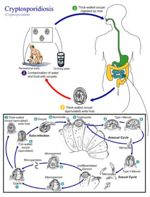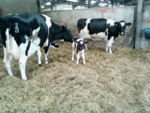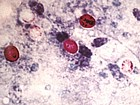Difference between revisions of "Cryptosporidium"
Jump to navigation
Jump to search
| Line 24: | Line 24: | ||
==Life Cycle== | ==Life Cycle== | ||
| − | Cryptosporidium mostly has a standard [[Coccidia | + | Cryptosporidium mostly has a standard [[Coccidia Life Cycle|coccidial life cycle]] with a few exceptions. The oocyte does not contain sporocysts, instead the sporozoites are free within the oocyst. The pre patent period of of cryptosporidium is 1 week, after which '''sporulated''' oocysts are shed in the hosts faeces. |
==Pathogenesis== | ==Pathogenesis== | ||
| Line 88: | Line 88: | ||
[[Category:Miscellaneous_Protozoa]] | [[Category:Miscellaneous_Protozoa]] | ||
| − | [[Category:Enteritis,_Parasitic]][[Category:Enteritis,_Villus_Atrophy]] | + | [[Category:Enteritis,_Parasitic]] |
| + | [[Category:Enteritis,_Villus_Atrophy]] | ||
[[Category:To_Do_-_NickJ]] | [[Category:To_Do_-_NickJ]] | ||
[[Category:To_Do_-_Parasites]] | [[Category:To_Do_-_Parasites]] | ||
| + | [[Category:To_Do_-_Coccidia]] | ||
Revision as of 14:54, 18 July 2010
| This article is still under construction. |
Overview
Cryptosporidium is the single genus in the cryptosporidiidae family and contains at least 13 recognised species. These small protozoan parasites are able to infect a wide range of hosts including mammals, birds, reptiles and fish.
Recognition
Cryptosporidium species are extremely small in size
- Parasitises epithelial cells lining the alimentary and respiratory tracts
- Developmental stages confined to the microvillous brush border
- C. parvum most associated with disease in domestic animals and in humans
- Other species affect birds
- Small oocysts of 4-5μm
Life Cycle
Cryptosporidium mostly has a standard coccidial life cycle with a few exceptions. The oocyte does not contain sporocysts, instead the sporozoites are free within the oocyst. The pre patent period of of cryptosporidium is 1 week, after which sporulated oocysts are shed in the hosts faeces.
Pathogenesis
- Causes outbreaks of diarrhoea in young animals
- Common cause of calf-hood scours
- Older animals may be asymptomatic carriers
- Contributes to undifferentiated neonatal calf diarrhoea which is a mixed viral enteritis in calves
- Common infection in AIDS patients
Epidemiology
- Direct faecal-oral infection
- E.g. School parties visiting farms
- Water-borne infection
- E.g. contaminated water supply may infect hundreds of people
- Difficult to locate source
Diagnosis
- Faecal smear
- Ziehl-Neelson (ZN) stain
- Oocysts stain red against a blue/green background
- Immunoassays
- Detect oocysts in faeces
Control
- Isolate/quarantine bought-in calves
- Treat if signs of diarrhoea present
- Good hygiene, adequate bedding and disinfection of calf pens is important
- Prevention/treatment
- Halofuginone
- Halocur or Intervet
- Oral dosage
- Halofuginone
Villus Atrophy in Enteritis
- Affects calf, lamb, piglet, kitten.
- Increasingly important as part of the neonatal diarrhoea complex in calves.
- Zoonosis.
Pathology
Gross
- Intestines diffusely reddened, with fluid contents.
Histological
- Tiny parasites on surface of epithelium.
- Villus atrophy and fusion.
- Iinflammation (mainly lymphoid) in crypts and lamina propria.




